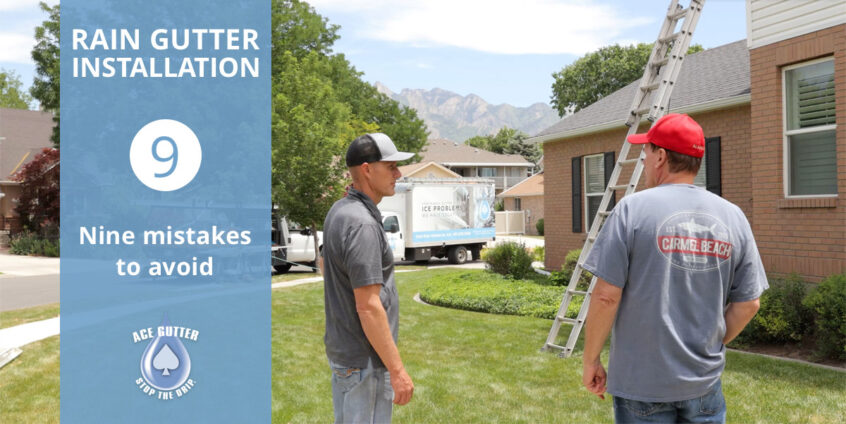Do you need new rain gutters?
Like most homeowners, you’ve probably thought about going the DIY route to save money. Before you start gathering supplies, know this: gutter installation is not easy. In fact, it can be a lot trickier than it looks.
Even small mistakes can lead to unhappy consequences, such as:
- Basement flooding
- Damage to stucco, siding, and foundation
- Insect and pest infestations
- Soil erosion around the home
- Ice dams in winter
Ideally, to avoid such problems, you should hire a professional gutter installation company. They have the experience and equipment to do things the right way.
However, if you’re still planning to take on rain gutter installation as a DIY project, there are a few rookie mistakes you should avoid. Let’s explore nine of them in detail.
1) Not Taking Gutter Pitch into Account
At first glance, rain gutters may look level. Upon closer inspection, you will find that they are mounted at a slight pitch. This angle affects how well the water drains away from your home.
If the pitch is too steep, the rainwater will run quickly, overflowing the gutters in the process. On the other hand, insufficiently pitched gutters will collect standing water, preventing it from moving towards the downspouts. Both these scenarios can cause serious damage to your home.
Start by calculating the ideal gutter pitch for your roof. As a rule of thumb, the pitch should not be more than half an inch for every ten feet of gutter.
Furthermore, make sure your rain gutters aren’t tilted forward. This can also lead to gutter overflow and cause a range of problems.
2) Selecting the Wrong Size
When it comes to gutters, there’s no one-size-fits-all solution. Generally, the steeper your roof pitch, the larger your gutters should be. The gutter size will also depend on the amount of rainfall you receive. Most residential homes in Utah use a 5 inch solution, called a 5K gutter.
To calculate what size gutters you require, consider the drainage area of your roof. For this, all you’ll need to do is multiply the length and width of your roof parts and add the values.
Although this sounds fairly straightforward, the math can get slightly more complicated if you have a multi-sectioned roof.
Next, figure out the rainfall intensity in your area. Do you get frequent downpours over many hours? Or does the rain only last for a few minutes? Depending on your answers, you’ll need a gutter that’s big enough to handle the rush of water.
If you’re finding it difficult to wrap your head around this, don’t hesitate to reach out to a professional contractor like Ace Gutter. We’ll be happy to answer all your questions regarding rain gutter installation and replacement.
3) Choosing the Wrong Type of Gutter
Size aside, you’ll also need to get the gutter type right. Your final choice will depend on:
- Material: Gutters made of copper and stainless steel are durable and weather-resistant – but they can be more expensive. Therefore, many homeowners prefer aluminum gutters because they’re sturdy, easy to install, and cost-effective.
- Design: Anyone in the market for a new gutter system has to select amongst a range of shapes and designs. While K-style gutters are the most popular, you can also choose from box style gutters, half-round gutters, and European-style gutters.
It’s worth noting that gutters come in two types of constructions: sectional and seamless. DIY gutters are sold in sections that snap into place. A major drawback to this design is that the seams tends to leak frequently.
Consequently, most contractors recommend professionally installed seamless gutters. Not only do they require less maintenance, but they can also go a long way to protect your home.
4) Leaving Wide Spaces Between Gutter Hangers
By definition, gutter hangers help anchor the gutters to your roof and keep the system stable, secure, and well-supported.
Unfortunately, many DIY installers place the gutter hangers too far apart. Leaving wide gaps between your gutter hangers can lead to sagging, especially when there is heavy snow or rainfall. This additional load can cause the gutters to separate from the home.
Talk to a roofing professional to figure out the ideal spacing for your gutter hangers.
5) Placing the Gutters Incorrectly
Contrary to popular belief, gutters don’t hang off the edge of your roof. This is because rainwater can pull back up under the roof and drip downwards. Alternatively, if the gutters hang too high, the rainwater will run behind them and damage the fascia boards.
To resolve this issue, expert roofers install gutters a few inches under the roof edge. This allows the rainwater to drain directly into the gutters. Because proper gutter placement is crucial to the integrity of your home, it’s best if you take your time to plan it out.
6) Installing the Downspouts in the Wrong Location
A gutter system isn’t all about the gutters. Downspouts complete your roof drainage process by:
- Determining where the water from the gutters goes
- Directing water away from the foundation of your home
- Preventing erosion around the yard
- Ensuring your basement doesn’t flood
The location of the downspouts can directly impact how well your gutter system performs. Install them in the wrong place, and you’ll be in for a world of trouble and heartache. This is another reason why you should consult a professionalbeforehand.
Since no two homes are the same, a gutter installation contractor will assess your unique drainage needs and determine exactly where each downspout should go. Moreover, they will let you know how many downspouts you’ll need.
7) Skimping on the Initial Purchase
While you may be tempted to invest in an economical rain gutter solution, remember that gutters are should be at least a long-term investment. If you skimp on the initial purchase, you may get stuck with a malfunctioning, inferior gutter system that needs frequent repairs.
To prevent this, prioritize quality over money. High-quality gutters may be more expensive, but they are more likely to pay off in the long run.
8) Not Adding Gutter Guards
Rain gutter guards (also known as gutter screens, gutter helmets, leaf guards, or gutter covers) are used to protect gutters from leaves, twigs, pine needles, and other debris.
Not only do they keep your gutters flowing freely, but they also:
- Prevent chronic clogging
- Reduce ice dam formations
- Fend off birds, rats, and other pests
- Reduce the likelihood of a fire
Unfortunately, many DIY installers make the mistake of skipping them. An effective gutter protection system can help you avoid the hassle of frequent gutter cleaning and repair. Be sure to conduct some research to find the right gutter guards for your home.
9) Working Without Proper Precautions
Did you know that ladder-related falls result in almost 37.3 million injuries around the world every year? More alarmingly, falls are the second-leading cause of unintentional deaths worldwide.
Ladder safety is of utmost importance when working with gutters. If you’re not careful, you may hurt yourself or someone else. Always ensure the ladder is well-balanced before you climb up. Additionally, have a helper nearby to keep an eye on your surroundings.
The Bottom Line on Installing Rain Gutters
We Utahans like to save a buck and enjoy DIY some projects. However, for some rain gutter installation can end up costing more in the long run when you have no prior experience of the job. Hopefully, this post has given you some insight into a few rain gutter installation mistakes you should avoid.
Are you thinking of upgrading your gutters? Do you need a professional gutter cleaning service for a routine cleanup?
The pros at Ace Gutter are here to help. From installing and cleaning rain gutters, installing leaf guards, to setting up ice melt systems for your roof, and to chimney caps, we do it all! Reach out to us with your questions or book a free bid today.


